Summary of Peredvizhniki
Established in 1870, The Society for Itinerant Art Exhibitions, commonly known as Peredvizhniki - meaning "Itinerants" or "Wanderers" - believed in representing subject-matter drawn from everyday life, with an accuracy and empathy which reflected their egalitarian social and political views. They worked across several types of painting, from landscape and portraiture to genre and historical painting, and by the close of the 19th century had become the most famous art movement in Russia. In 1923 the group was disbanded, but its impact was felt across many subsequent genres of Russian art, from Neo-Primitivism to Socialist Realism.
Key Ideas & Accomplishments
- The Peredvizhniki artists were perhaps best-known for their landscapes, paintings of archetypal Russian settings such as pine forests, wheat fields, and water meadows, which depicted their subject-matter with near photographic accuracy. At the same time, these landscapes were symbolically significant, representing the mood of the painter or viewer - as in the so-called "lyrical landscape" - or summing up some archetypal aspect of Russian culture or character.
- Peredvizhniki was the first group of Russian artists to recognize that the everyday Russian citizen was a worthy subject of their attention. They set about creating portraits and genre paintings which evoked aspects of the worker or peasant's daily life, or their hopes, fears, and allegiances. In an era where focusing on the common man or woman was synonymous with political radicalism, this work effectively sounded a clarion call for democratic reform.
- Peredvizhniki was the first great nationalist movement within Russian art. Rejecting what they saw as the Academy's slavish adherence to European taste, they forged a body of work which could become a talisman for an independent Russian spirit. Through their historical and religious paintings, for example, they presented the events and figures who had shaped the collective Russian consciousness.
- Like many of their peers in the French Realist movement of the mid-19th century, the painters of Peredvizhniki were striving not just for a new stylistic paradigm within their nation's art, but for sweeping social and political change. But if Gustave Courbet's involvement with the Paris Commune of 1870 symbolized an unrewarded revolutionary fervor, the Peredvizhniki movement survived to witness the Russian Revolution of 1917, and thus for the transformation it had willed: if not in the form it would have expected.
Artworks and Artists of Peredvizhniki

Barge Haulers on the Volga
Ilya Repin's painting, arguably the defining work of Peredvizhniki, shows a group of exhausted men in harness pulling a barge along the sandy banks of the Volga. The composition emphasizes the harrowing effort of their labor, the diagonal line of workmen mirrored by the diagonal line of the shore (as if the whole scene were responding to and compounding the scale of their task). The laborers at the front of the line are larger, tilting forward with slack arms as if bearing down upon the viewer - the front man fixes our gaze pointedly - while the men that follow seem on the verge of collapse; at the end of the line, one figure slumps forwards, as if only held upright by the strap around his torso. In the distance to the left, a barge with sails unfurled can be seen on the still reflective waters: perhaps an ironic nod to Romantic landscape painting, emphasizing the abjection of the central scene.
Repin began making preliminary sketches for this work in situ on the Volga in 1870, though the painting took three years to finish. Each of the barge haulers was based upon a real person whom Repin encountered during this preliminary visit, such as Kanin, a former priest, and Konstantin, a former icon painter. By using a wide, narrow canvas to accentuate the line of men, and by working with a high degree of naturalistic detail - creating precise tonal gradations, for example, and contrasting the lightness of the landscape with the shadow surrounding the men - Repin transformed what might otherwise have been a staid work of genre painting into a harrowing masterwork of Realism.
Repin was the most famous artist in Russia by the close of the 19th century: the almost uncanny visual and psychological accuracy of works such as Barge Hailers influenced a whole generation of painters, and also had a deep effect on the nation's social conscience. The work was arguably all the more powerful because, as Vladimir Stasov wrote, it was "not painted to move the viewers to pity," but simply to "show [...] the types of people Repin saw."
Oil on canvas - Russian Museum, St. Petersburg
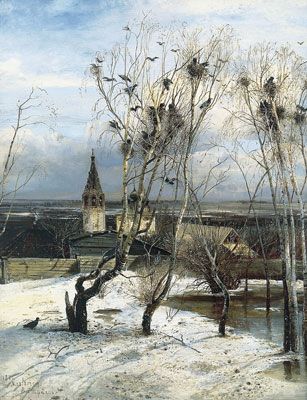
The Rooks Have Come Back
Alexei Savrasov's landscape painting shows a group of bare, twisted trees on a snow-covered hillside in front of a monastery. In the distance, beyond the steeple, a snowy expanse stretches to the horizon, generating a sense of enveloping isolation. The white of the snow and tree trunks, and the sharp angles of the walls and spires, create a kind of harsh clarity, suggesting the biting cold of the winter, but the top half of the canvas is dominated by billowing clouds and blue sky, and by the rooks which flock to the tops of the trees, heralding the spring.
Savrasov painted almost exclusively in the landscape genre, and was associated with the development of so-called "lyrical landscape", a genre associated with the Peredvizhniki group in which the landscape becomes a mirror for human emotions. During the 1860s he had travelled to Europe, and had been influenced by Romantic landscape painters of the Swiss (Alexandre Calame) and British (John Constable) schools, but this work conveys a distinctly Russian spirit. It practical terms, it represents the area around the Ipatiev Monastery in Kostroma, a provincial town 200 miles north-east of Moscow.
Seen as the high-point of Savrasov's career, The Rooks Have Come Back is at once a highly allegorical work, showing the replenishment of the landscape after winter, and a piece of almost informal-seeming naturalism. It was well-received when it was shown at the first Peredvizhniki touring exhibition of 1871, and was later admired by Isaac Levitan, a pupil of Savrasov's whose emotionally evocative landscapes would themselves become famous. As Levitan put it, the work is "very simple, but beneath the simplicity [...] is the tender artist's soul".
Oil on canvas - The State Tretyakov Gallery, Moscow
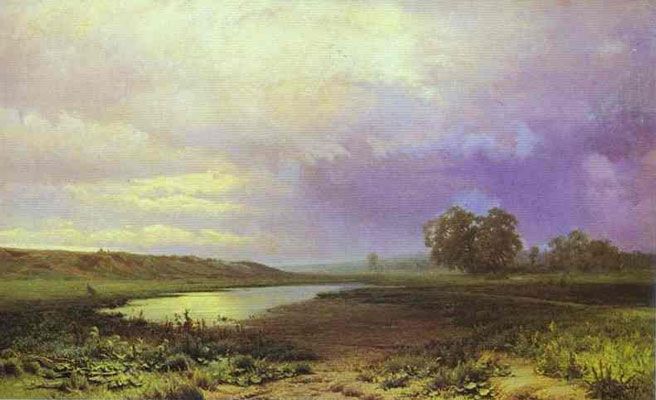
Wet Meadow
This painting, depicting a water-meadow in the Russian countryside, is sometimes taken as the founding work of the "lyrical landscape" style, and is a classic example of Peredvizhniki landscape painting. In the foreground, scrubby vegetation is picked out with naturalistic detail; behind, a patch of earth leads in zig-zag pattern to a shallow lake, which in turn forms a curving diagonal drawing the eye upwards to the tree on the horizon line. The sky, filled with low-lying clouds, and the earth, are presented as contrasting areas of light and dark, with a shadow cast across the whole ground, stretching from left to right of the canvas.
Though he was only twenty in 1870, Fyodor Vasilyev became one of the founding members of Peridvizhniki, and by the time he composed Wet Meadow in 1872 he had already collaborated with, and been tutored by, some of the most important artists attached to the movement. In 1867, he spent several months working on Valaam Island with the landscape painter Ivan Shishkin; in 1870, he travelled to the Volga with Ilya Repin - the trip on which Repin made his preparatory sketches for Barge Haulers - creating works in response such as Volga View: Barges (1870). A year later, in 1871, Vasilyev's painting The Thaw propelled him to fame - a copy was ordered by the family of the Tsar - as a result of which his friendship with Shishkin devolved into a rivalry. This particular work was created in the Crimea, while Vasilyev was attempting to recover from Tuberculosis. Its composition is based on memories of his native Russian landscapes, which perhaps helped to concentrate the strongly emotive mood of the piece.
Vasilyev never recovered from his illness, dying in 1873 at the age of 23. However, by this point he had already produced a body of work that would have a profound influence on the development of landscape painting within the Peredvizhniki group, inspiring artists such as Isaac Levitan and Valentin Serov.
Oil on canvas - The State Tretyakov Gallery, Moscow
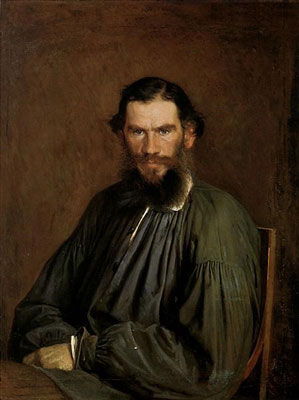
Portrait of Leo Tolstoy
This portrait shows the venerated 19th-century Russian writer Leo Tolstoy in three-quarter pose, gazing intently at the viewer. His hands lie in his lap, suggesting self-containment or withdrawal, while the black frock coat wrapped around his shoulders lends him a priestly demeanor. The wall behind the writer is blank, implying a life of austere solitude, though his face registers quiet, even humorous contentment.
Ivan Kramskoi was the leader of the "revolt of fourteen" out of which Peredvizhniki developed, and was renowned for his portraiture, including works depicting everyday Russians such as Portrait of a Peasant (1868), and others focused on Peredvizhniki members, such as Portrait of the Artist Konstantin Savitsky (1871). Tolstoy was already famous by the time he granted Kramskoi the commission for this portrait - an honor sought by many artists, and only secured after some persuasion - and following the sitting the two would become close friends, corresponding on the state of Russia and the ideals of Russian art. Proper to Tolstoy's developing reputation as an ethical and religious figurehead as well as a great writer, Kramskoi conveys a clear sense of moral authority, and of humane and perceptive attentiveness. Many of Kramskoi's sitters became iconic figures, and it is likely that the qualities suggested by this painting enhanced the Tolstoy myth. As for Tolstoy himself, he grew to like Kramskoi so much that he included a character based on him in Anna Karenina (1877), and would later remark of his Christ in the Wilderness (1872) that "he knew no better Christ."
This is an important work of Peredvizhniki art not only in showing the achievements of their leader, but also in indicating the channels of mutual influence between writing and painting which characterized Russian culture during the 1860s and 70s. Both Kramskoi and Tolstoy were working to define not only a new Russian art, but also a new moral and social conscience for their nation.
Oil on canvas - The State Tretyakov Gallery, Moscow
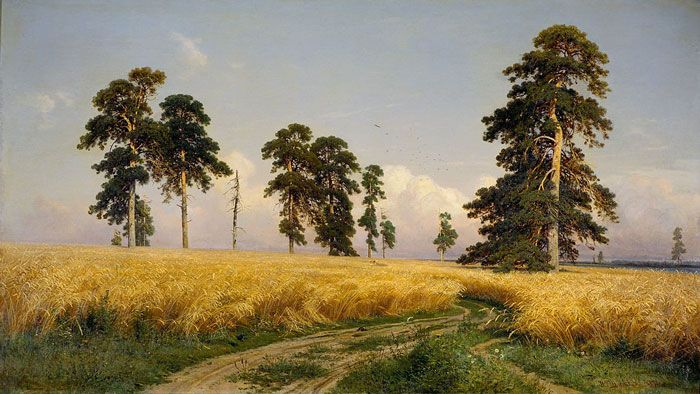
Rye
This iconic landscape painting shows a field of rye just before harvest season. The intense color of the composition suggests the heat of late summer, the field burgeoning with its yield; in the foreground, wild flowers in blossom are picked out with the artist's customary precision, while the curve of the track draws the eye towards the center of the painting, echoed by the curves in the rye-stalks. Pine trees punctuate the skyline, and billowing clouds fill the air.
Ivan Shishkin is remembered as the master of Perdvizhniki landscape painting, especially for his forest scenes and works depicting trees, such as Oak Grove (1887) and Forest Distance (1884). But whereas his contemporaries Vasilyev and Savrasov presented the landscape as a frame for the human condition, Shishkin was renowned for his scientific attention to natural detail; though this work is also replete with symbolic meaning. The painting depicts the rye fields of Lekarevskoe, at the edge of Yelabuga, the town where Shishkin was born and one of the engines of Russia's agricultural economy, known as 'Russia's Granary'. In this sense, the piece is a nationalistic paean to the wealth and plenitude of the Russian land. At the same time, it has a more poignant, biographical significance, having been composed based on material gathered during a trip to Yelabuga in 1877, after the death of Shishkin's wife and two sons. The two barely discernible figures in the center of the canvas are assumed to be Shishkin and his daughter - his last surviving relative during that trip - while the two black swallows in the foreground, and the larger, dead bird on the road, seem highly allegorical.
The painting thus represents the loss and replenishment of life - human and natural - whilst also being a meticulous representation of a particular landscape, one which epitomized everything that Shishkin loved about the Russian countryside: "expansiveness; space; fields of rye; God's paradise; Russian riches..." It was his ability to convey the character of that landscape both realistically and emblematically that made him an enduringly influential figure in modern Russian art.
Oil on canvas - The State Tretyakov Gallery, Moscow
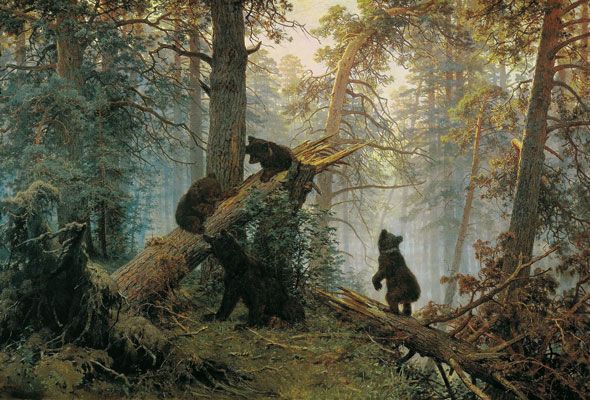
Morning in a Pine Forest
This canvas shows four bears, a mother and her cubs, playing around a fallen tree in a forest glade lit up by the morning sun. The triangular arrangement of the animals matches the triangular shape formed by the fallen pine at the center, which directs the eye towards the haze of sunlight behind. The cub to the right, outlined against the light, creates another focal point, while the verticals of the surrounding trees, reaching up beyond the top of the canvas, immerse the viewer in the woodland scene. A bluish morning mist clings to the trunks on the left-hand side.
Painted around a decade after Rye, Morning in a Pine Forest is one of various works which Shishkin created throughout his career depicting lush coniferous woodland, also including Pine Forest (1866) and The Sestroretsk Forest (1896). The natural scene is recreated in such detail - each pine needle in its variation, the plants mingling in the foreground, the backwards-curving trunk behind the fallen tree - that the effect is of a near-photograph freshness. In this sense, the work is a quintessential example of Shishkin's oeuvre, but it is relatively unusual in representing animals. Indeed, when the painting was first shown at a Peredvizhniki exhibition, it was presented as a collaboration with Konstantin Savitsky, a painter known mainly for his working-class portraits who was thought to be responsible for the depiction of the bears. This is quite likely, but Savitsky's signature was later removed from the piece, and it was credited solely to Shishkin.
This painting was well-received at the time, and remains popular to the point of cultural ubiquity in Russia. It is regularly cited as one of the nation's favorite paintings, and since 1925 a version of the image has appeared on the wrapper of the popular Clumsy Bear chocolate bar.
Oil on canvas - The State Tretyakov Gallery, Moscow
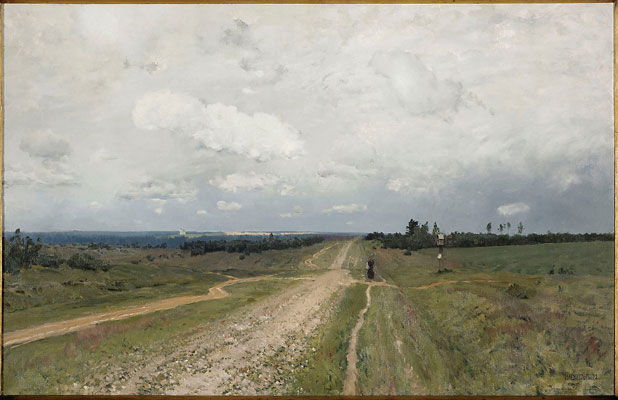
Vladimirka (The Road to Vladimir)
This atmospheric landscape painting depicts the Vladimirka Road, part of the Great Siberian Road that led from Moscow to the wilderness areas of Northern Russia. The surface of the track seems to be broken up by grass and wagon ruts, as it cuts upwards from the left foreground, forming a disappearing diagonal reaching to the horizon. The vastness of the land and sky is emphasized by their emptiness - save for a single clump of trees, and a tiny church spire in the distance - and by the presence of a single pilgrim, passing an icon-and-cross station located to the right of the road.
Levitan was a master of plein air painting. Often creating his works on location, he had the ability, like the French Impressionist painters of his era, to capture the atmosphere of a natural setting on a particular day, at a particular time, through an intuitive use of color. In this case, the atmosphere generated might seem subtly oppressive, the sky an icy blue-grey, the horizon a source of shadow rather than light. That mood is complemented by the impression of lonely penitence conveyed by the presence of the pilgrim, and - if the viewer knows anything of the location they are looking at - by the cultural associations of the landscape itself. The Great Siberian Road was associated with the transportation of prisoners north from Moscow to Siberian workcamps or to exile, a journey famously taken by Raskolnikov in Dostoevsky's Crime and Punishment (1866), and recalled in the memoirs of the political activist Alexander Herzen. The poet Nikoly Nekrasov had also presented a (fictionalized) account of the journey in his 1872 work Russian Women.
In its cultural and emotional allusiveness, Levitan's work is a classic example of the Russian "lyrical landscape"; indeed, he brought to all his natural scenes a poetic sensibility to match that of the writers who had described the journey along the Vladimir Road. Such psychologically affecting works would have a profound influence on subsequent Russian painters, including the Impressionist Konstantin Korovin and the Symbolist Mikhail Nesterov.
Oil on canvas - The State Tretyakov Gallery, Moscow
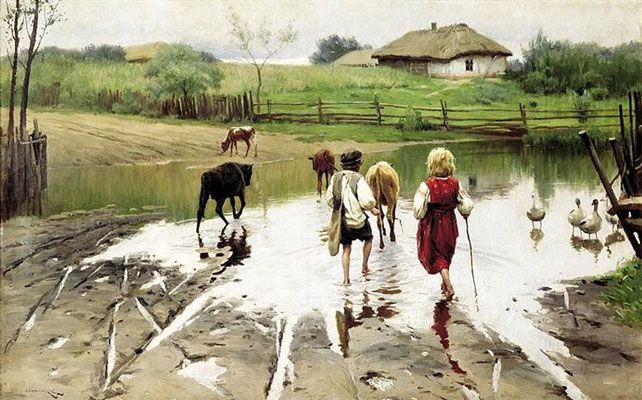
A Ford
This classic late work of Peredvizhniki genre paintings shows two children driving a small herd of calves across a shallow ford in a rural village. In the foreground, the track is deeply rutted by coach-wheels, filled with water lit up by the sun, while the children's movement away from the viewer, and their depiction mid-stride, creates a sense of informality and photographic accuracy, as if relaying a particular moment in time. In compositional terms, the road-surface forms a diagonal sweep across the canvas, while the angle of the fence on the far side of the ford parallels the line of the hill beyond.
Pymonenko was a second-generation Peredvizhik, born in 1862, just a year before the "revolt of the fourteen", and only eleven years old at the time of the first Itinerant Exhibition. Enrolled as a member of the group in 1899, he produced scenes of working-class and peasant life, many of which, such as Victim of Fanaticism (1899), contain a strong element of ethical and social commentary. This work is relatively unusual in the simple, idyllic nature of the scene depicted, though perhaps the prominent groove-lines imply the children's future lives unfolding along predictable and arduous paths.
Works like A Ford, and Matchmakers (1882), sum up Pymonenko's detailed and empathetic attentiveness to everyday Russian life. He was the best-known Ukrainian artist associated with Peredvizhniki, and later in his life would forge an unexpected connection with the future Suprematist painter Kazimir Malevich, a pupil at the Kyiv Art School where Pymonenko worked from 1906.
Oil on canvas - Odesa Museum of Fine Arts, Odesa, Ukraine
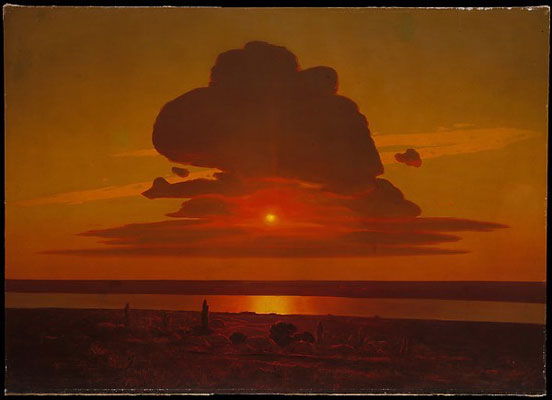
Red Sunset on the Dnieper
This painting, depicting a sunset on the Dnieper River, is dominated by a large luminous body of cloud. The red glow of the sun behind it, reflecting on the river, fills the entire canvas with unearthly light, while in the foreground the thatched roofs of huts can just be made out. However, the viewing point appears to be in mid-air, so that the scene below is flattened and miniaturized, the top half of the canvas given over entirely to the representation of the sky.
The Ukrainian-born artist Arkhip Kuindzhi initially worked as a retoucher in a photography studio, and had considered opening a studio himself before becoming a painter. As a result, his work, like that of the French Impressionists, was deeply influenced by photography: this piece is exemplary in using unexpected color combinations and fine tonal gradations to capture the dramatic effects of sunlight in realistic ways. His paintings often present vast, empty panoramas, in which the features of the landscape are reduced to a minimum and the refraction and reflection of light becomes the primary object of attention. In this case, the scene becomes almost abstracted in its minimalism, the river banks forming homogenous dark bands on either side of the luminous strip of water.
In its exaggerated, emotionally expressive use of color, and in its move towards a kind of compositional abstraction, Kuindzhi's work became a touchstone for Russian painters of the Symbolist and Expressionist schools, such as Nicholas Roerich, Konstantin Bogaevsky, and Arkady Rylov. In this sense, his work indicates the threads of continuity that run from Perdvizhniki Realism to later movements in Russian and European art, suggesting the significance of the movement as a whole.
Oil on canvas - The Metropolitan Museum of Art, New York
Beginnings of Peredvizhniki
Artel of Artists
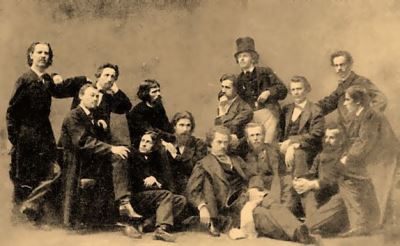
Peredvizhniki developed out of The Artel of Artists, a cooperative commune established in 1863 following what was called the "revolt of fourteen." This came about when fourteen young artists, all studying at the St. Petersburg Academy of Art, rebelled against the choice of topic for the annual Gold Medal competition, "The Entrance of Odin into Valhalla". The group felt that the topic summed up the Academy's stifling focus on the Neoclassical tradition, and wanted to paint the reality of contemporary Russian life, learning from the examples of Realism and Naturalism in Europe.
The leader of the rebellion was Ivan Nikolaevich Kramskoi, a student at the Academy since 1857, who had become increasingly dissatisfied with the conservatism of Russian art and society. Influenced by the literary critics Vissarion Grigoryevich Belinsky and Nikolay Chernyshevsky, Kramskoi became an increasingly vocal advocate for democratic reforms, arguing for the social and political responsibility of the artist, and for the development of a specifically Russian art. Finding the Academy hostile to both his political and his artistic views, he became the figurehead for a growing number of restless young students.
The Society for Itinerant Art Exhibitions
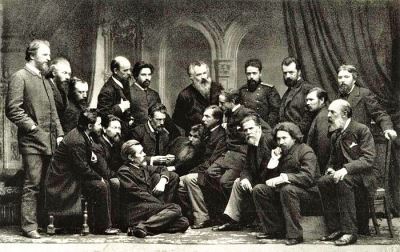
Having established the Artel of Artists in 1863, in 1870 the group led by Kramskoi began plans to hold a series of "Itinerant Art Exhibitions", to be held in provincial locations and funded without state assistance, displaying the achievements of Russian art to the common man and woman. These were the founding activities of Peredvizhniki, a group also including Vasily Grigoryevich Perov, Nikolai Ge, and Grigory Myasoyedov. Perov, the eldest of them, was already well-known for his genre paintings, such as Arrival of a New Governess in a Merchant House (1866), and his tutelage of younger artists such as Nikolai Kasatkin, Konstantin Korovin, Isaac Levitan, Abram Arkhipov, and Mikhail Nesterov, would have a significant impact on the group's artistic development.
The first of Peredvizhniki's "Itinerant Art Exhibitions" was held in 1871, and from then on the group organized a series of shows across Russia, accompanied by artists' lectures, and talks on social and political reform. These exhibitions also created a new marketplace, a context in which artists could sell their work independently of Academic patronage, to an increasingly prosperous middle class. Between 1871 and 1923, no fewer than 47 exhibitions were organized by Peredvizhniki, in cities such as Kyiv, Odesa, Kazan, Orel, and Riga, as well as Moscow and St. Petersburg.
Vissarion Grigoryevich Belinsky and Nikolai Chernyshevsky
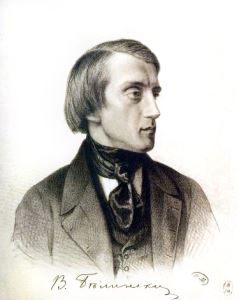
Vissarion Belinsky was a noted literary critic, whose writing on Russian prose became a vehicle for his progressive political views. He was an ardent critic of serfdom, a system he described as "trampling upon anything that is remotely human", and of the autocracy of Tsarist government. Belinsky's influence on Russian society was so profound that the novelist Fyodor Dostoevsky was sentenced to four years in a Siberian prison camp for reading and planning to distribute one of Belinsky's letters attacking the feudal system. Like the great prose stylists whose work he promoted - Dostoevsky, Ivan Turgenev - Belinsky believed in a type of writing that would express a social conscience, and transcribe the psychological reality of lived experience.
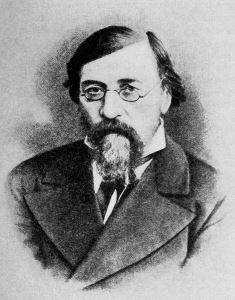
Nikolay Gavrilovich Chernyshevsky was a writer and literary critic whose famous novel What Is to be Done? (1862) transformed public consciousness around the issue of serfdom (its title was later borrowed by Lenin for his revolutionary pamphlet of 1902). Partly as a result, Chernyshevsky - who was influenced by Belinsky - became a leading voice of revolutionary democratic movements in Russia, and the head of the Narodniks, a populist movement within the middle classes who felt that only the peasantry could overthrow the monarchy and establish a socialist regime. In 1874, the Narodniks began - in their words - "going to the peasants" to persuade them to revolt; the idea was very similar to that expressed by the Peredvizhniki exhibitions, which took art to the villages as a pretext for social reform.
Sovremennik Magazine
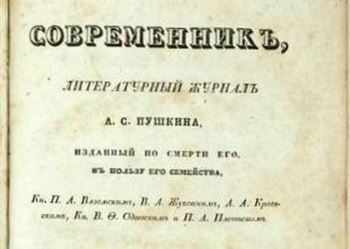
Sovremennik ("The Contemporary") was a magazine launched by the poet Alexander Pushkin, though its first issue was published following his unexpected death in a duel in 1836. The magazine became one of Russia's leading literary journals, printing work by the most famous writers of the golden age of Russian prose, including Ivan Turgenev, Dmitry Grigorovich, Alexander Druzhinin, and Leo Tolstoy.

Vissarion Belinsky became involved with the magazine in the late 1840s, at which point it was managed by the poet Nikolay Nekrasov and the critic Ivan Panaev. Often threatened with official censorship, but avidly consumed by the intelligentsia, Sovremmenik continued to appear until 1866. Between 1853 and 1862 Chernyshevsky edited the magazine printing his own work in it, such as his academic thesis The Aesthetic Relations of Art to Reality (1855), which called for an art that would "reproduce nature and life." The young members of the Artel of Artists were deeply influenced by the radical ideas espoused in Sovremmenik, seen as one of the motivating factors behind their own revolt in 1863.
Pavel Mikhaylovich Tretyakov and Vladimir Vasilievich Stasov
Important early supporters of the Peredvizhniki artists included the art critic Vladimir Stasov - who was particularly influential in justifying their naturalistic treatment of social reality - and the collector Pavel Tretyakov. Stasov was the most respected critic of his era, a venerated figure who felt that Russian art should be "authentic, genuine, and not trivial." He believed that "after long years of scarcity, pretense, and imitation," such an art had finally been cultivated by Peredvizhniki, particularly as they had succeeded in freeing their work from European influence.
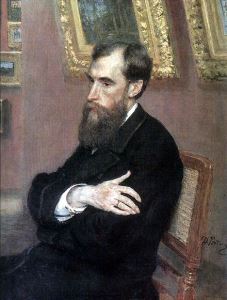
Tretyakov was a wealthy businessman and banker who began collecting art in 1854, with the aim of creating a National Gallery in Russia. He was an avid collector and supporter of the Peredvizhniki, buying works at their exhibitions and direct from the artists' studios, sometimes purchasing complete series of paintings at once. As a result, he held the largest collection of works by Perov, Repin, Kramskoi, Levitan, Serov, and various other Peredvizhniki artists. He also commissioned original work by the artists, including portraits of noted Russians, and often provided financial assistance to group members who were struggling to pay their way. In 1893, he established the Moscow City Gallery of Pavel and Sergei Tretyakov, now known as the Tretyakov Gallery, where many Peridvizhniki works can still be viewed.
Peredvizhniki: Concepts, Styles, and Trends
Though perhaps best-known for their landscape paintings, the Peredvizhniki artists also worked across several other genres, including portraiture, genre painting, and historical and religious art, as evidenced by the wide-ranging oeuvre of Ilya Repin, the most famous figure attached to the group. Rebelling against the Neoclassical tradition of the Academy, Perdvizhniki sought to redefine the relative importance assigned to different types of painting by the Academic art-world, feeling that a historical painting, for example, was no more or less significant than a genre painting; they often sought to create work which combined the conventions of particular genres. Nonetheless, it is still possible to assess their achievements by reference to various inherited 'types' of painting: from landscapes and portraits to genre paintings and historical and religious works.
Landscape
The extent of Peredvizhniki's interest in landscape painting varied. Some artists, such as the renowned Ivan Shishkin, focused primarily on the genre, producing works - such as Oak Grove (1887) - displaying a rapt attentiveness to the natural environment. Indeed, Shishkin became so identified with his images of forests that he was dubbed 'the singer of the forest' or 'Tsar of the forest.' Yet some critics argued that, for all their realism, his landscapes were too understated in their emotional content.
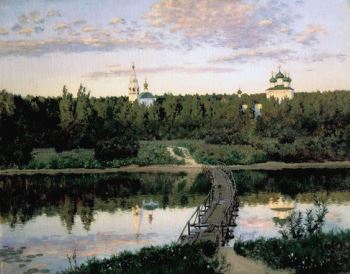
By contrast, the artist Alexei Kondratyevich Savrasov, with works such as The Rooks Have Come Back (1871), created so-called "lyrical landscapes" or "mood landscapes", a creative path followed by younger artists such as Fyodor Alexandrovich Vasilyev, Nikolay Nikanorovich Dubovskoy, and Isaac Ilyich Levitan. Levitan, whose Secluded Monastery (1890) is another good example of this genre, was devoted to painting on location, and his understanding of light and color enabled him to capture the psychological and emotional impact of certain natural scenes with extraordinary accuracy. His work was seen as a radical departure from the conventions of the landscape genre, transcending naturalistic depiction to present landscapes as vessels or mirrors for human thought and emotion.
A more luminous treatment of landscape, emphasizing color and light in more exaggerated ways, is found in the work of Arkhip Ivanovich Kuindzhi, while a further version of the Peredvizhniki landscape style is provided by the paintings of Ilya Yefimovich Repin. The most famous artist of the group, Repin's landscapes often focused on the human figure, as in Ploughman (1887), for example, which presents the famous writer Leo Tolstoy plowing a field.
Portraits
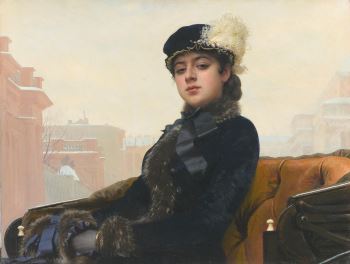
The most well-known portraitist amongst the Peredvizhniki group was Kramskoi, who was celebrated not only for his portraits of noted Russians such as Tolstoy and Tretyakov, but also for his paintings of the Russian peasantry, and other real-life subjects. Works of Kramskoi's such as Portrait of An Unknown Woman (1883) capture the complexity of the individual subject while simultaneously blending and subverting the tropes of portraiture and genre painting. Nikolai Ge, Vasily Perov, Nikolai Yaroshenko, Valentin Serov, and Nicolai Kuznetsov were also known for their portraits. Despite their opposition to the stereotypical constraints of the genre, Peredvizhniki's portrait paintings often depict figures seen to exemplify some particular aspect of Russian identity, as in Serov's Portrait of the Composer Nikolai Rimsky-Korsakov (1898) and Kuznetsov's Portrait of Pyotr Ilyich Tchaikovsky (1893), both of which focus on famous composers and Russian cultural icons.
Genre Painting
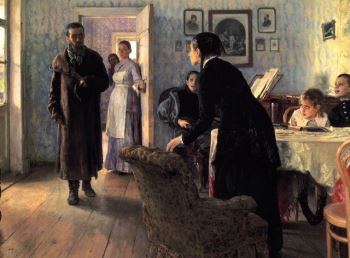
The St. Petersburg Academy considered historical painting a higher form of art than genre painting, but the Peredvizhniki painters felt that genre painting - in short, the painting of scenes from everyday life - could be used to represent important moments in Russian history, and to capture the realities of Russian life. Perov's early genre work played an important role in establishing the group's emphasis on genre painting, but it was Ilya Repin's masterful Barge Haulers on the Volga (1870-73) that set the standard for painting in this style, constituting both a striking landscape and a psychologically harrowing portrait of Russian working life.
A number of other Peredvizhniki painters also excelled in genre work. Vladimir Makovsky's work often focused on urban life, bringing an emotional and occasionally satirical scrutiny to city-scenes, as in his On the Boulevard (1887), which depicts an alienated couple on a park bench. Mykola Pymonenko, a Ukrainian artist of a younger generation, was a similarly talented genre painter, though he focused on rural rather than city life, as in A Ford (1901). From the 1880s onwards, the genre painting of Peredvizhniki took a markedly political cast, with works such as Repin's Unexpected Visitor (1886) - which shows a hollow-eyed young man returning to his family after political exile - and Pymonenko's Victim of Fanaticism (1899).
Historical and Religious Painting

Despite opposing the bias in favor of history painting within the Academy, the Peredvizhniki artists themselves created historical scenes, though mainly based on episodes drawn from Russian national history (rather than classical antiquity). The most famous of these was perhaps Repin's Reply of the Zaporozhian Cossacks to Sultan Mehmed IV of the Ottoman Empire (1880-91), depicting the legendarily obscene response of the Ukrainian Cossacks to the Ottoman Sultan's demand for surrender following a 17th-century battle; it was described by the artist as "a study in laughter." Vasily Surikov became well-known for his trilogy of historical paintings The Morning of the Streltsy Execution (1881) - focused on Peter the Great's brutal suppression of a military revolt - Menshikov in Berezovo (1888) - showing a 17th-century military leader in exile - and Boyarynya Morozova (1887), which depicts the folk hero Feodosia Morozova at the moment of her arrest for resistance to religious reforms in 1671. All of these paintings represented pivotal and painful moments in the birth of the modern Russian state.
The works of Nikolai Ge and Kramskoi, by contrast, frequently focused on religious themes. Kramskoi's Christ in the Desert (1872) was exhibited at the second Peredvizhniki exhibition, with the contemporary critic Ivan Goncharov praising the depiction of Christ's "pauper appearance, under the rags, in humble simplicity, inseparable [from] true majesty and force." Older than most of Peredvizhniki, Ge became associated with the group late in his career, and continued to focus on religious subjects to an unusual degree, as in What Is Truth? (1890), a late work showing Christ being questioned by Pontius Pilate. In Orthodox Russia, religious paintings were seen as depicting historical fact, and for the Peredvizhniki artists, the figure of Christ - presented as poor, humble, and deeply human - became a symbol for the suffering of the common Russian.
Later Developments - After Peredvizhniki
Following a pattern repeated throughout the history of modern art, the initially revolutionary methods of Peredvizhniki had themselves been institutionalized by the 1890s, with many of the movement's key artists accepting teaching positions at the Imperial Academy. Indeed, by the turn of the century, oeuvres such as Repin's were perceived as monuments to a new creative orthodoxy, and younger artists increasingly viewed Peredvizhniki style with skepticism or frustration. In 1898, the art patron Sergei Pavlovich Diaghilev - later famous for founding the Ballets Russes- established the group Mir Iskusstva (World of Art), which promoted new artists and movements in effective defiance of the Peredvizhniki hegemony.
The response to these new developments within the group itself was resistance in some instances, friendship and support in others, as in the notable case of the ageing Stasov. Younger artists associated with Peredvizhniki, such as Konstantin Korovin, Isaac Levitan, and Valentin Serov, also became allies of Diaghilev. Partly as a result, while early-20th-century artists were often outwardly hostile to the legacy of the group, their work continued to display the impact of Peredvizhniki techniques and concepts. The painters Natalia Goncharova and Mikhail Larionov, for example, who were responsible for defining Russian Primitivism and Rayonism - two of the most important styles within Russian avant-garde art of the 1910s - both advocated for the specific genius of Russian art, and for the depiction of working and rural life. Kazimir Malevich, who founded the Suprematist movement in 1913, went on to create works depicting peasants on Soviet collective farms, such as Mower (1930), which showing thematic influence of his teacher Pymonenko; we can also sense Peredvizhniki themes and tropes in Sergev Konenkov's sculptures, and in the Post-Impressionist landscapes of Konstantin Ivanovich Gorbatov. Even Russian Futurism, in its clamor for a new, egalitarian Russian society, arguably expressed the indirect influence of the Peredvizhniki ethos.
The group's most superficial cultural legacy, however, was rather bleaker, standing for the new cultural autocracy which gripped post-revolutionary Russia. In 1922, Peredvizhniki was replaced by the Association of Artists of Revolutionary Russia (AARR), led by Pavel Radimov - the last leader of Peredvizhniki - and incorporating other realist painters from the older group. The AARR rejected new developments in avant-garde art, and became closely associated with the advent of Socialist Realism during the 1930s. The emphasis on realistic representation and everyday subject-matter which had been so subversive in the 1860s thus became the basis for a constrictive orthodoxy, with Ilya Repin's work presented as the exemplar of Soviet art for decades.
All art movements, however, accommodate individuals of skill and significance, and many of those who became attached to Socialist Realism, such as Kuzma Petrov-Vodkin, were initially inspired or incited by Peredvizhniki. Isaac Levitan's landscapes, whose non-human subject-matter in a sense transcended the cultural battles of the 1930s, were lauded by very different movements and figures, from Diaghilev to the Socialist Realist painter Czeslaw Znamierowski. Indeed, just as Levitan's work stood aloof from the Realist/Avant-garde debate, Znamierowski's Impressionist-influenced landscapes avoided the more explicitly propagandist motifs of Socialist Realism while remaining culturally acceptable in mid-century USSR. Later in the 20th century, artists of the so-called Nonconfirmist School, such as Oleg Vassiliev, arguably carried the progressive spirit of Perdvizhniki forwards.
Works by the Peredvizhniki artists themselves have become ingrained in Russian cultural consciousness, as evidenced by the send-up of Repin's Barge Haulers in various political cartoons, and the naming of minor planets after Shishkin and Tretyakov by Soviet astronomers. As for the group's reception in the west, the influential American critic Clement Greenberg, in his 1939 article "Avant-Garde and Kitsch" cited Repin's Reply of the Cossacks (1880-91) as a particularly ignoble example of Kitsch. Perhaps as a result, the group's work was ignored to some extent for the following decades, though that situation began to change around the start of the 21st century.
Useful Resources on Peredvizhniki
-
![Ilya Repin - The Art of Russia - Roads to Revolution]() 29k viewsIlya Repin - The Art of Russia - Roads to RevolutionOur PickBBC4
29k viewsIlya Repin - The Art of Russia - Roads to RevolutionOur PickBBC4 -
![Ivan Shishkin: A collection of 352 paintings (HD)]() 187k viewsIvan Shishkin: A collection of 352 paintings (HD)LearnfromMasters
187k viewsIvan Shishkin: A collection of 352 paintings (HD)LearnfromMasters -
![Ivan Kramskoi: A collection of 149 paintings (HD)]() 52k viewsIvan Kramskoi: A collection of 149 paintings (HD)LearnfromMasters
52k viewsIvan Kramskoi: A collection of 149 paintings (HD)LearnfromMasters
-
![An introduction to Peredvizhniki: Pioneers of Russian Painting]() 1k viewsAn introduction to Peredvizhniki: Pioneers of Russian PaintingWith curator Per Hedström. In Swedish with English subtitles / By National Museum, Stockholm, Sweden
1k viewsAn introduction to Peredvizhniki: Pioneers of Russian PaintingWith curator Per Hedström. In Swedish with English subtitles / By National Museum, Stockholm, Sweden -
![Interview with guest curator David Jackson on Peredvizhniki: Pioneers of Russian Painting]() 900 viewsInterview with guest curator David Jackson on Peredvizhniki: Pioneers of Russian PaintingOur PickBy National Museum, Stockholm, Sweden
900 viewsInterview with guest curator David Jackson on Peredvizhniki: Pioneers of Russian PaintingOur PickBy National Museum, Stockholm, Sweden
 Ask The Art Story AI
Ask The Art Story AI















